Rixin Zhou
LadderMoE: Ladder-Side Mixture of Experts Adapters for Bronze Inscription Recognition
Oct 02, 2025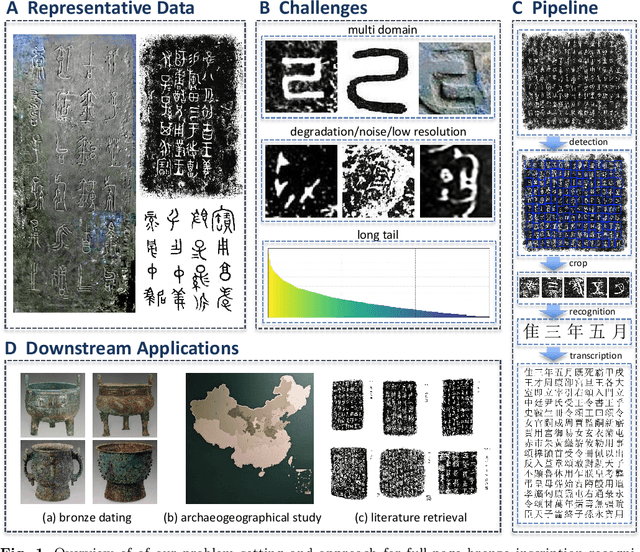

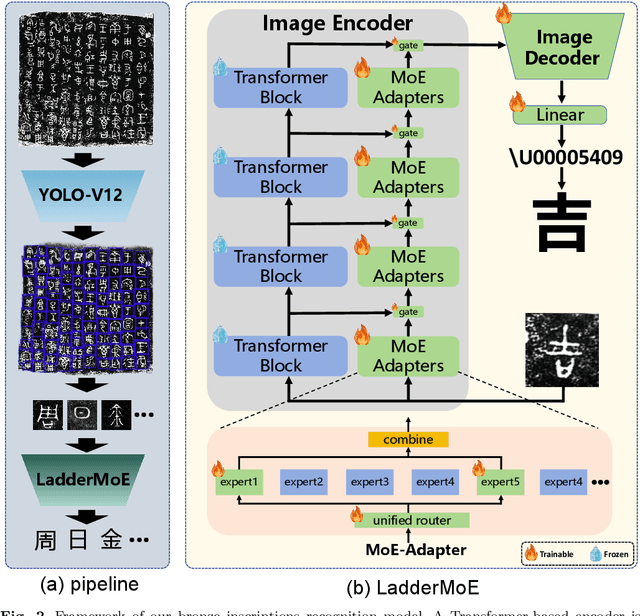

Abstract:Bronze inscriptions (BI), engraved on ritual vessels, constitute a crucial stage of early Chinese writing and provide indispensable evidence for archaeological and historical studies. However, automatic BI recognition remains difficult due to severe visual degradation, multi-domain variability across photographs, rubbings, and tracings, and an extremely long-tailed character distribution. To address these challenges, we curate a large-scale BI dataset comprising 22454 full-page images and 198598 annotated characters spanning 6658 unique categories, enabling robust cross-domain evaluation. Building on this resource, we develop a two-stage detection-recognition pipeline that first localizes inscriptions and then transcribes individual characters. To handle heterogeneous domains and rare classes, we equip the pipeline with LadderMoE, which augments a pretrained CLIP encoder with ladder-style MoE adapters, enabling dynamic expert specialization and stronger robustness. Comprehensive experiments on single-character and full-page recognition tasks demonstrate that our method substantially outperforms state-of-the-art scene text recognition baselines, achieving superior accuracy across head, mid, and tail categories as well as all acquisition modalities. These results establish a strong foundation for bronze inscription recognition and downstream archaeological analysis.
ShiftedBronzes: Benchmarking and Analysis of Domain Fine-Grained Classification in Open-World Settings
Dec 17, 2024Abstract:In real-world applications across specialized domains, addressing complex out-of-distribution (OOD) challenges is a common and significant concern. In this study, we concentrate on the task of fine-grained bronze ware dating, a critical aspect in the study of ancient Chinese history, and developed a benchmark dataset named ShiftedBronzes. By extensively expanding the bronze Ding dataset, ShiftedBronzes incorporates two types of bronze ware data and seven types of OOD data, which exhibit distribution shifts commonly encountered in bronze ware dating scenarios. We conduct benchmarking experiments on ShiftedBronzes and five commonly used general OOD datasets, employing a variety of widely adopted post-hoc, pre-trained Vision Large Model (VLM)-based and generation-based OOD detection methods. Through analysis of the experimental results, we validate previous conclusions regarding post-hoc, VLM-based, and generation-based methods, while also highlighting their distinct behaviors on specialized datasets. These findings underscore the unique challenges of applying general OOD detection methods to domain-specific tasks such as bronze ware dating. We hope that the ShiftedBronzes benchmark provides valuable insights into both the field of bronze ware dating and the and the development of OOD detection methods. The dataset and associated code will be available later.
PairingNet: A Learning-based Pair-searching and -matching Network for Image Fragments
Dec 14, 2023Abstract:In this paper, we propose a learning-based image fragment pair-searching and -matching approach to solve the challenging restoration problem. Existing works use rule-based methods to match similar contour shapes or textures, which are always difficult to tune hyperparameters for extensive data and computationally time-consuming. Therefore, we propose a neural network that can effectively utilize neighbor textures with contour shape information to fundamentally improve performance. First, we employ a graph-based network to extract the local contour and texture features of fragments. Then, for the pair-searching task, we adopt a linear transformer-based module to integrate these local features and use contrastive loss to encode the global features of each fragment. For the pair-matching task, we design a weighted fusion module to dynamically fuse extracted local contour and texture features, and formulate a similarity matrix for each pair of fragments to calculate the matching score and infer the adjacent segment of contours. To faithfully evaluate our proposed network, we created a new image fragment dataset through an algorithm we designed that tears complete images into irregular fragments. The experimental results show that our proposed network achieves excellent pair-searching accuracy, reduces matching errors, and significantly reduces computational time. Details, sourcecode, and data are available in our supplementary material.
Multi-Granularity Archaeological Dating of Chinese Bronze Dings Based on a Knowledge-Guided Relation Graph
Mar 27, 2023
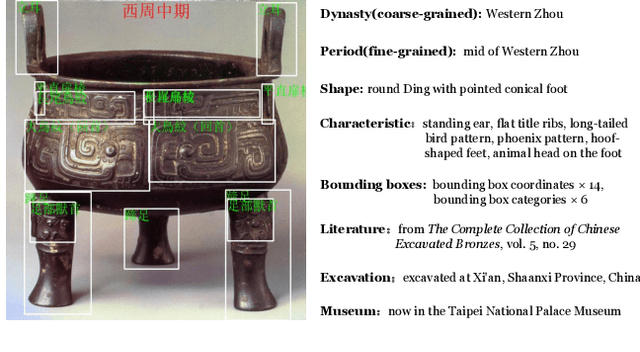
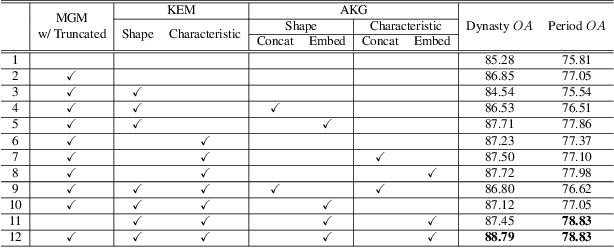
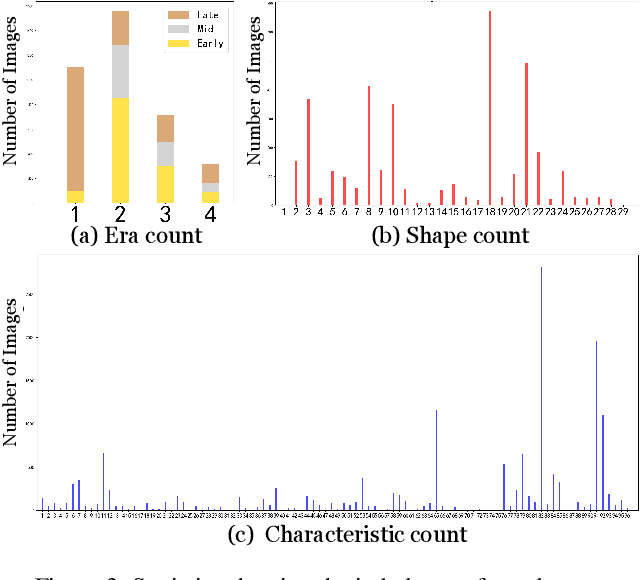
Abstract:The archaeological dating of bronze dings has played a critical role in the study of ancient Chinese history. Current archaeology depends on trained experts to carry out bronze dating, which is time-consuming and labor-intensive. For such dating, in this study, we propose a learning-based approach to integrate advanced deep learning techniques and archaeological knowledge. To achieve this, we first collect a large-scale image dataset of bronze dings, which contains richer attribute information than other existing fine-grained datasets. Second, we introduce a multihead classifier and a knowledge-guided relation graph to mine the relationship between attributes and the ding era. Third, we conduct comparison experiments with various existing methods, the results of which show that our dating method achieves a state-of-the-art performance. We hope that our data and applied networks will enrich fine-grained classification research relevant to other interdisciplinary areas of expertise. The dataset and source code used are included in our supplementary materials, and will be open after submission owing to the anonymity policy. Source codes and data are available at: https://github.com/zhourixin/bronze-Ding.
 Add to Chrome
Add to Chrome Add to Firefox
Add to Firefox Add to Edge
Add to Edge